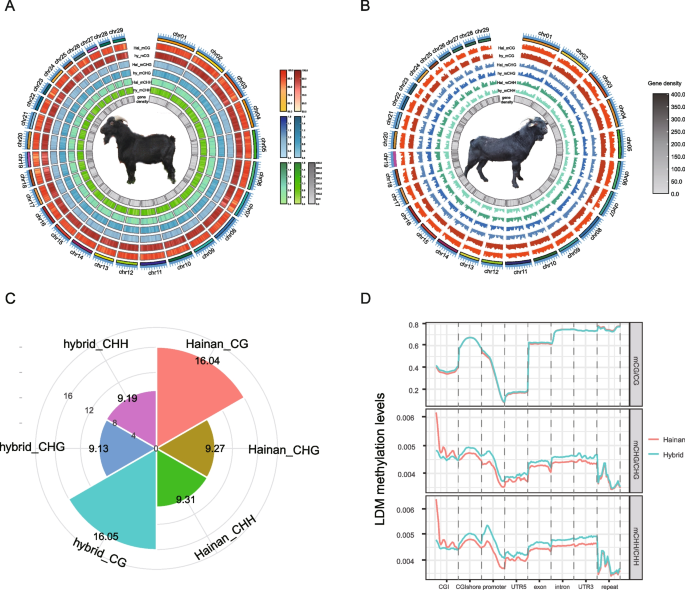Diverse WGBS profiles of longissimus dorsi muscle in Hainan black goats and hybrid goats
IF 2.9
Q2 Biochemistry, Genetics and Molecular Biology
引用次数: 0
Abstract
Goat products have played a crucial role in meeting the dietary demands of people since the Neolithic era, giving rise to a multitude of goat breeds globally with varying characteristics and meat qualities. The primary objective of this study is to pinpoint the pivotal genes and their functions responsible for regulating muscle fiber growth in the longissimus dorsi muscle (LDM) through DNA methylation modifications in Hainan black goats and hybrid goats. Whole-genome bisulfite sequencing (WGBS) was employed to scrutinize the impact of methylation on LDM growth. This was accomplished by comparing methylation differences, gene expression, and their associations with growth-related traits. In this study, we identified a total of 3,269 genes from differentially methylated regions (DMR), and detected 189 differentially expressed genes (DEGs) through RNA-seq analysis. Hypo DMR genes were primarily enriched in KEGG terms associated with muscle development, such as MAPK and PI3K-Akt signaling pathways. We selected 11 hub genes from the network that intersected the gene sets within DMR and DEGs, and nine genes exhibited significant correlation with one or more of the three LDM growth traits, namely area, height, and weight of loin eye muscle. Particularly, PRKG1 demonstrated a negative correlation with all three traits. The top five most crucial genes played vital roles in muscle fiber growth: FOXO3 safeguarded the myofiber’s immune environment, FOXO6 was involved in myotube development and differentiation, and PRKG1 facilitated vasodilatation to release more glucose. This, in turn, accelerated the transfer of glucose from blood vessels to myofibers, regulated by ADCY5 and AKT2, ultimately ensuring glycogen storage and energy provision in muscle fibers. This study delved into the diverse methylation modifications affecting critical genes, which collectively contribute to the maintenance of glycogen storage around myofibers, ultimately supporting muscle fiber growth.

海南黑山羊和杂交山羊背长肌的 WGBS 特征多样性
自新石器时代以来,山羊产品在满足人们的饮食需求方面发挥了至关重要的作用,在全球范围内产生了许多具有不同特征和肉质的山羊品种。本研究的主要目的是通过DNA甲基化修饰,确定海南黑山羊和杂交山羊背最长肌(LDM)中调控肌纤维生长的关键基因及其功能。采用全基因组亚硫酸盐测序(WGBS)来仔细检查甲基化对LDM生长的影响。这是通过比较甲基化差异、基因表达及其与生长相关性状的关联来完成的。在这项研究中,我们从差异甲基化区(DMR)中鉴定了总共3269个基因,并通过RNA-seq分析检测了189个差异表达基因(DEGs)。Hypo DMR基因主要富集于与肌肉发育相关的KEGG中,如MAPK和PI3K-Akt信号通路。我们从网络中选择了11个与DMR和deg内的基因集相交的枢纽基因,其中9个基因与腰眼肌的面积、高度和重量这三个LDM生长性状中的一个或多个具有显著相关性。特别是,PRKG1与这三个性状均呈负相关。前5个最关键的基因在肌纤维生长中起着至关重要的作用:FOXO3保护肌纤维的免疫环境,FOXO6参与肌管的发育和分化,PRKG1促进血管舒张释放更多的葡萄糖。这反过来又加速了葡萄糖在ADCY5和AKT2的调控下从血管向肌纤维的转移,最终确保了肌纤维中的糖原储存和能量供应。本研究深入研究了影响关键基因的各种甲基化修饰,这些修饰共同有助于维持肌纤维周围的糖原储存,最终支持肌纤维的生长。
本文章由计算机程序翻译,如有差异,请以英文原文为准。
求助全文
约1分钟内获得全文
求助全文
来源期刊

BMC Genetics
生物-遗传学
CiteScore
4.30
自引率
0.00%
发文量
77
审稿时长
4-8 weeks
期刊介绍:
BMC Genetics is an open access, peer-reviewed journal that considers articles on all aspects of inheritance and variation in individuals and among populations.
 求助内容:
求助内容: 应助结果提醒方式:
应助结果提醒方式:


